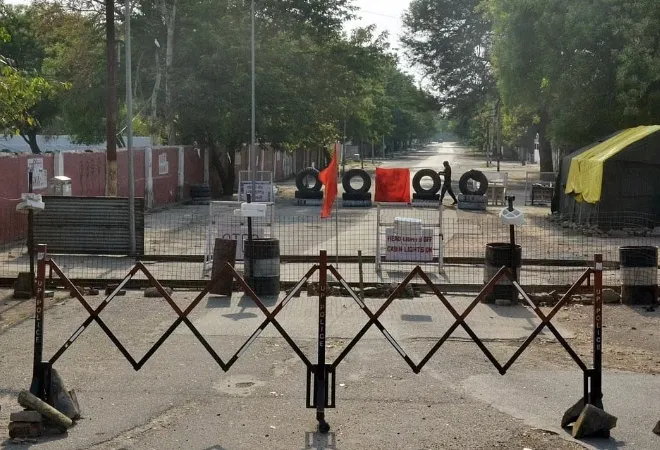-
CENTRES
Progammes & Centres
Location
There are concerns about how well the newly merged cantonments will be governed under the ULBs

On 27 April 2023, the Ministry of Defence issued a notification for the abolition of Yol Cantonment in Himachal Pradesh. This is part of an overall plan of the Ministry to disband all cantonments after carving out the military areas and declaring them as ‘exclusive military stations’ under the complete control of the army. Areas of the cantonment that would stand severed from the military station would be merged with the neighbouring urban local body (ULB). The plan that has been kickstarted with Yol will be carried forward and applied to all 62 cantonments in the country, 56 established before India’s independence and six after 1947. Ajmer was the last notified cantonment in 1962.
The 62 cantonments are unevenly spread across the country. The army’s Northern Command has only one within its physical jurisdiction; four are located in the Eastern Command, 13 in the Western, 19 under the Southern, and 25 fall under the jurisdiction of the Central Command. These have now been termed as ‘archaic colonial legacies’, created by the East India Company post-victory in the battle of Plassey and the resultant suzerainty over parts of India. As their area of control and rule expanded, more military stations and cantonments were created. The primary objective behind their establishment was the quartering of troops. However, as a consequence of the need for backup amenities, civilian populations found residence in the jurisdiction of cantonments. They provided a variety of support activities that the cantonments required. The physical layout, over time, got clearly demarcated, comprising a somewhat integrated and yet separate military area, the civil area and the bazaar area.
Areas of the cantonment that would stand severed from the military station would be merged with the neighbouring urban local body (ULB).
The decision to carve out the civilian areas from the core military stations may require certain hurdles to be crossed. Bisecting cantonments may be a simple process in many of them. Others may be difficult. The easy ones would be those where civilian areas and military stations are well-demarcated. However, wherever these areas are intertwined, the process may present formidable obstacles, and may even prevent segregation. Delhi and Lucknow were cited as two such difficult examples by the defence ministry officials.
The overall administration of the cantonments is currently in the hands of the cantonment boards that are ‘deemed municipalities’. The boards comprise elected representatives as well as ex-officio and nominated members as per the Cantonments Act, 2006. The station commander of the cantonment is the ex-officio president of the board and an officer of the Indian Defence Estates Service (IDES) or Defence Estates Organisation is the chief executive officer and member-secretary of the board. The boards have a term of five years and are classified into four categories depending on their size and population. Category I cantonments are those with populations above 50,000; Category II between 10,000 and 50,000; Category III between 2,500 and 10,000, and Category IV with populations below 2,500. A cantonment differs from a military station—the latter is exclusively devoted to the use and accommodation of military personnel and is established under an executive order. The cantonment, on the other hand, is an area that comprises both military and civilian populations. In practice, however, some civilian populations have also been found present within military stations. The cantonment boards perform such civic duties as public health, water supply, sanitation, primary education, and street lighting, quite similar to what the ULBs perform.
The pros and cons of the abolition and merger of cantonments sans military stations into ULBs have been debated in the past and there have been voices both in support and against such a move. This article attempts a dispassionate view of the Government of India’s (GOI) decision to merge but is primarily concerned with the fallouts on the concerned ULBs that would have to govern the merged areas.
The station commander of the cantonment is the ex-officio president of the board and an officer of the Indian Defence Estates Service (IDES) or Defence Estates Organisation is the chief executive officer and member-secretary of the board.
For the military commanders, the excision of civilian areas would relieve them of the onerous responsibilities of carrying out civilian functions and taking decisions on non-military matters that essentially affect the local civilian population. Considerable time of theirs was taken up by these chores, resulting in distracting them from their primary duties of training and war preparedness. The army officers, many times, were found getting involved in local politics, an area for which they had little background and no training. It was also felt that this would allow uniform homogenous management of military stations strictly under army control.
From the point of view of civilians residing in the cantonments, there would be relief from the extremely restrictive regulations imposed on property holders, especially in regard to the process of transfer and mutation of properties held on grant or lease, and severe restrictions on construction. There would also be a respite from troublesome road closures, causing huge inconvenience to the civilian population in their movements. The civilian population will now also have access to social welfare schemes of GoI and state governments that were unavailable to them while they were part of the cantonments. Development funds could not go to cantonments since the Ministry of Defence happened to be in the non-plan sector.
Fears have been expressed in some quarters that the merger of cantonment areas in ULBs would, in all probability, lead to a sudden spurt in uncontrolled construction and commercialisation. Some of these cantonments are hill stations, and their charm in the coming days would be lost. While this is a possibility, it is also true that many of the cantonment towns have had their economies stunted on account of stifling restrictions on any growth. Census 2011, for instance, revealed that Pune Cantonment lost a population of more than 8,000 between 2001 and 2011. Similarly, Aurangabad cantonment lost 1,121 persons and Delhi cantonment lost 14,566 persons during the same period. Clearly, the process of urbanisation in these areas was severely impeded and the cantonment restrictions aggravated the demographic and built pressure on the cities in which they found themselves located and sometimes encircled.
The civilian population will now also have access to social welfare schemes of GoI and state governments that were unavailable to them while they were part of the cantonments.
Property holders in the merged areas would find relief since municipal laws would henceforth apply to them. Hence, they would get to build more and the localised processes would quicken the pace of decision-making. The merger would in all likelihood lead to the removal of stifling restrictions on construction and economic activity and provide a catalytic force to propel more urbanisation in those areas. That would yield some revenue for ULBs but have some environmental impact in the bargain. In permitting construction, ULBs would have to take care such that construction abides by the Defence Act, which prohibits construction within 1,000 yards of defence works.
The most worrying part, however, of the merger of civilian areas of the cantonments in ULBs is that the municipalities, in general, would be found seriously wanting in providing the amalgamated areas with decent standards of services. The quality of civic services is not likely to improve; neither are these citizens likely to get better governance. Cities are already struggling in reaching services to areas within their fold. They are short of manpower; their financial position is precarious and their capacities are low. The new areas are going to bring insufficient revenue and the states are not inclined to help cities. Neither would the old councillors allow money from their own political constituencies to be diverted to newer areas. Future mergers would be one more proof that cities cannot be left to fend for themselves and that GoI and the states need to step in to fund the growing unfunded mandate of the cities.
Ramanath Jha is Distinguished Fellow at Observer Research Foundation
The views expressed above belong to the author(s). ORF research and analyses now available on Telegram! Click here to access our curated content — blogs, longforms and interviews.

Dr. Ramanath Jha is Distinguished Fellow at Observer Research Foundation, Mumbai. He works on urbanisation — urban sustainability, urban governance and urban planning. Dr. Jha belongs ...
Read More +